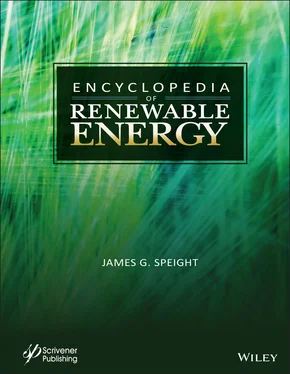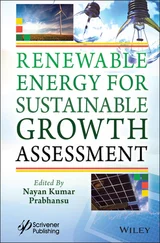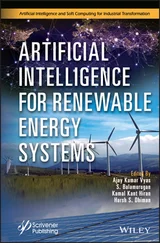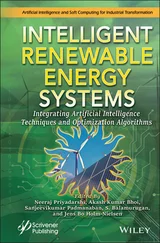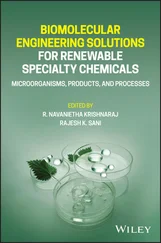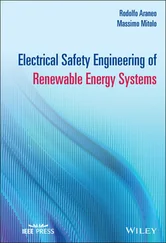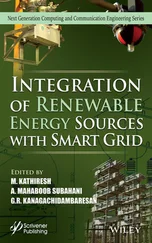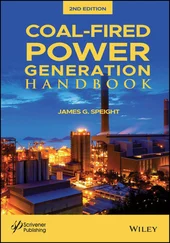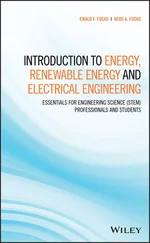James G. Speight - Encyclopedia of Renewable Energy
Здесь есть возможность читать онлайн «James G. Speight - Encyclopedia of Renewable Energy» — ознакомительный отрывок электронной книги совершенно бесплатно, а после прочтения отрывка купить полную версию. В некоторых случаях можно слушать аудио, скачать через торрент в формате fb2 и присутствует краткое содержание. Жанр: unrecognised, на английском языке. Описание произведения, (предисловие) а так же отзывы посетителей доступны на портале библиотеки ЛибКат.
- Название:Encyclopedia of Renewable Energy
- Автор:
- Жанр:
- Год:неизвестен
- ISBN:нет данных
- Рейтинг книги:3 / 5. Голосов: 1
-
Избранное:Добавить в избранное
- Отзывы:
-
Ваша оценка:
- 60
- 1
- 2
- 3
- 4
- 5
Encyclopedia of Renewable Energy: краткое содержание, описание и аннотация
Предлагаем к чтению аннотацию, описание, краткое содержание или предисловие (зависит от того, что написал сам автор книги «Encyclopedia of Renewable Energy»). Если вы не нашли необходимую информацию о книге — напишите в комментариях, мы постараемся отыскать её.
Written by a highly respected engineer and prolific author in the energy sector, this is the single most comprehensive, thorough, and up-to-date reference work on renewable energy.
Encyclopedia of Renewable Energy: Audience
Encyclopedia of Renewable Energy — читать онлайн ознакомительный отрывок
Ниже представлен текст книги, разбитый по страницам. Система сохранения места последней прочитанной страницы, позволяет с удобством читать онлайн бесплатно книгу «Encyclopedia of Renewable Energy», без необходимости каждый раз заново искать на чём Вы остановились. Поставьте закладку, и сможете в любой момент перейти на страницу, на которой закончили чтение.
Интервал:
Закладка:
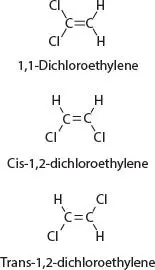
If chemicals have become subsurface contaminants that threaten important drinking water resources. A strategy to remediate such polluted subsurface environments is with the help of the degradative capacity of bacteria.
See also: Alicyclic Hydrocarbons, Alkaloids.
Aquatic Organisms
Aquatic organisms can be classified into each varying in the biological characteristics, habitat, and adaptations, but linked within a complex network of ecological roles and relationships.
Microorganisms (algae, bacteria, and fungi) are living catalysts that enable a vast number of chemical processes to occur in water and soil. The living organisms (biota) in an aquatic ecosystem may be classified as either autotrophic or heterotrophic. Autotrophic organisms utilize solar or chemical energy to fix elements from simple, nonliving inorganic material into complex life molecules that compose living organisms. Algae are typical autotrophic aquatic organisms. Generally, carbon dioxide (CO 2), nitrate (NO 3), and phosphate derivatives (PO 43-) are sources of carbon, nitrogen, and phosphorus, respectively, for autotrophic organisms. Organisms that utilize solar energy to synthesize organic matter from inorganic materials are called producers.
Macrophytes are individual aquatic plants that can be seen by the unaided eye and can be categorized based on where and how they grow. Rooted macrophytesare rooted in the riverbed or lake substrate, and are thus restricted to areas where flow is low enough to permit fine sediments to accumulate. Rooted macrophytes may have leaves entirely submerged (under the water), floating on the surface, or emergent above the surface. In turbid water, little light penetrates and photosynthesis is restricted; hence, only plants with floating or emergent leaves can thrive. Rooted macrophytes may extract nutrients from the substrate as well as absorbing them from the water as algae do. Floating aquatic macrophytes are rootless plants that persist only in backwater areas where the flow slackens—otherwise, they are carried downstream. Because their photosynthetic surfaces are above the water surface, these plants can grow in deep, turbid water and places where rooting sites are sparse.
Macrophyte abundance can fluctuate seasonally as a result of scouring of the bottom sediments and washout of plants during heavy rains. For this reason, the number of macrophytes in river channels generally peaks during periods of low flow. Aquatic macrophytes are important in many aquatic systems, especially wetlands, slower moving water in streams and rivers, and in shallower areas of lakes. Aquatic macrophytes add three-dimensional complexity to aquatic habitat, and can provide habitat, refuge, and spawning areas for animals such as aquatic insects and fish, as well as a surface for periphyton growth. As they are primary producers, aquatic macrophytes produce organic matter which can be eaten by some fish; however, most of this plant material is unpalatable to herbivores while it is alive.
Large populations of aquatic macrophytes can have negative effects on aquatic ecosystems and the people that rely on them. In some cases, floating plants are so numerous that they form dense mats covering the water surface. Their buoyant leaf crowns merge above the surface, while the root masses dangle below into the water. The interlocking vegetation mat blocks light penetration down the water column and prevents the growth of other plants. In extreme cases, the underlying water becomes deoxygenated, and floating plants turn into a nuisance by inhibiting the passage of boats and interfering with fishing. Invasive species of macrophytes can be particularly disruptive to natural aquatic ecosystems.
Invertebrates include all animals without a backbone .Invertebrates are far more diverse and abundant than vertebrates, and many groups of invertebrates are found in aquatic systems. Invertebrates living on or in aquatic sediments are termed benthic invertebrates. Benthic invertebrate communities – including measurements of population abundance and diversity – are often used as indicators of aquatic ecosystem health.
Zooplankton are aquatic animals that cannot swim against water currents, typically because they are too small to do so. However, many zooplankton can swim significant distances in fairly still waters. Because they cannot swim against currents, zooplankton are more important in lakes than in running water, as running water usually carries them downstream faster than they can reproduce. However, they can be abundant in large slow flowing rivers. Zooplankton are heterotrophic and are significant sources of energy and nutrients to carnivorous invertebrates and some vertebrates.
Heterotrophic organisms utilize the organic substances produced by autotrophic organisms as energy sources and as the raw materials for the synthesis of their own biomass. Decomposers (or reducers) are a subclass of the heterotrophic organisms and consist of chiefly bacteria and fungi, which ultimately break down material of biological origin to the simple compounds originally fixed by the autotrophic organisms.
Insects are the most diverse group of animals on earth – most insects are terrestrial, while some have life stages that are aquatic (such as dragonflies and mosquitoes). Some insects are entirely aquatic (such as the aquatic beetles). While most aquatic insects live on or near the bottom of waterbodies, though some can swim into the water column. Most aquatic insects have gills and need water with dissolved oxygen, while others, such as mosquito larvae, breathe through the surface film of still waters. Stream and river insects are crucial in the processing of organic matter. Some scrape biofilm; others shred larger leaves into smaller particles, while still others filter or collect these smaller particles. This chain of processing reduces large organic matter to successively smaller and smaller particles.
Fish display every major feeding type: (i) herbivorous fish feed on periphyton or macrophytes, or may even filter phytoplankton from the water, (ii) carnivorous fish feed on mollusks, worms, insects, zooplankton, and other fish, (iii) omnivorous fish may feed on specific types of prey, or feed indiscriminately on nearly anything they can consume. Due to this diversity in modes of feeding, different fish can occupy different places in a food chain.
As with feeding behavior, some fish occupy specific habitats, while others can be found in a wide variety of lakes and rivers. The distribution of fish can be influenced by a large number of factors, including (i) oxygen concentration, (ii) temperature, (iii) the presence of macrophytes, (iv) the availability of suitable substrate for spawning, and (v) current speed in streams and rivers. Changes in fish habitat (such as reduction of flooding due to damming) can favor some types of fish, and disadvantage others.
See also: Aquasphere.
Aquatic Plants
Aquatic plants (also known as hydrophytic plants, hydrophytes) are plants that have adapted to living in aquatic environments and are also referred to as hydrophytes or macrophytes to distinguish them from algae and other microphytes. A macrophyte is a plant that grows in or near water and is emergent, submergent, or floating. The three types of aquatic plants are (i) submerged aquatic weeds. submerged plants are rooted in the pond bottom and grow up through the water column, (ii) emergent aquatic weeds, and (iii) free floating aquatic weeds.
Aquatic plants include kelp from the ocean, and freshwater plants such as algae, water hyacinth, and duckweed. Aquatic plants are considered to be a sub-category of biomass and the plants, like wood products, dried vegetation, and crop residues, have the potential to produce biomass fuels.
Читать дальшеИнтервал:
Закладка:
Похожие книги на «Encyclopedia of Renewable Energy»
Представляем Вашему вниманию похожие книги на «Encyclopedia of Renewable Energy» списком для выбора. Мы отобрали схожую по названию и смыслу литературу в надежде предоставить читателям больше вариантов отыскать новые, интересные, ещё непрочитанные произведения.
Обсуждение, отзывы о книге «Encyclopedia of Renewable Energy» и просто собственные мнения читателей. Оставьте ваши комментарии, напишите, что Вы думаете о произведении, его смысле или главных героях. Укажите что конкретно понравилось, а что нет, и почему Вы так считаете.
